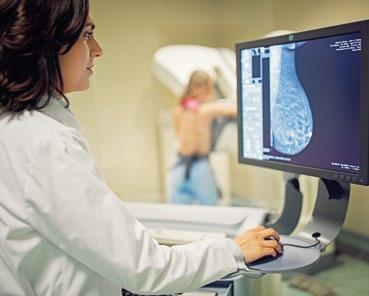
3 minute read
Oestrogen, progesterone and breast
from EYES Newsletter Winter 2021 /22 (The newsletter of the ESE Young Endocrinologists and Scientists)
Oestrogen, progesterone, and breast cancer:
a two-sided story
Advertisement
Ovarian function declines steadily towards menopause. Both oestrogen and progesterone levels change in the years prior to the final menstrual period. Thereafter, progesterone is almost undetectable, whereas oestrogen remains in low range mainly due to adipose tissue and aromatase activity which are the main sources of endogenous oestrogen synthesis in menopausal women. Oestrogen levels correlate strongly with body mass index (BMI) and BMI correlates strongly with breast cancer risk1. Furthermore, most oestrogen receptor (ER+) positive breast cancer occurs after menopause.
Prior to the Women’s Health Initiative (WHI) trial results in 2002, menopausal hormone therapy was generally accepted as appropriate and safe. However, the unexpected findings of breast cancer risk in women taking oral conjugated equine oestrogens (oCEE) and medroxyprogesterone acetate, led many women to stop taking, and many physicians to stop prescribing, menopausal hormone therapy. Further, in the general public, it led to overall misunderstanding that all menopausal hormone therapy modalities are the same and carry the same risks2 .
The 2012 a WHI sub-analysis reviewed the risk of breast cancer diagnosis in the oCEE-alone study arm showing that with oestrogen use, there was a lower incidence of breast cancer compared with placebo, mortality per year from breast cancer was less than that seen in controls who did not use menopausal hormone therapy, and in fact, fewer women in the oestrogen-alone group than the control group died from any cause3. This led to the conclusion that adding a progestogen to menopausal hormone therapy increases the risk of breast cancer.
However, there are two sides to every story. Studies examining the breast cancer risk with respect to different progestogens showed that there is some risk with certain progestins, but not when natural (micronized) progesterone or dydrogesterone are used2. In fact, the in vitro and in vivo studies of Jason Carroll’s group (Cambridge, UK) show that progesterone has a protective role in breast tissue and antiproliferative role in ER+ breast cancer. Furthermore, they propose that the lack of progesterone in menopausal women allows unopposed oestrogen activity contributing to the increase in ER+ breast cancer incidence in a postmenopausal context2 .
The benefits of menopausal hormone therapy outweigh the risks – we all agree on that. We also support the initiation of treatment for symptomatic women who are under the age of 60 or within 10 years of menopause and without contraindications4, 5, 6 .
Ljiljana Marina,
Serbia
REFERENCES
1. Key, T J et al. “Body mass index, serum sex hormones, and breast cancer risk in postmenopausal women.”
Journal of the National Cancer Institute vol. 95,16 (2003): 1218-26. doi:10.1093/jnci/djg022 2. Carroll, Jason S et al. “Deciphering the divergent roles of progestogens in breast cancer.” Nature reviews.
Cancer vol. 17,1 (2017): 54-64. doi:10.1038/nrc.2016.116 3. Anderson, Garnet L et al. “Conjugated equine oestrogen and breast cancer incidence and mortality in postmenopausal women with hysterectomy: extended follow-up of the Women’s Health Initiative randomised placebo-controlled trial.” The Lancet. Oncology vol. 13,5 (2012): 476-86. doi:10.1016/
S1470-2045(12)70075-X 4. The NAMS 2017 Hormone Therapy Position Statement Advisory Panel. “The 2017 hormone therapy position statement of The North American Menopause Society.” Menopause (New York, N.Y.)vol. 24,7 (2017): 728-753. doi:10.1097/GME.0000000000000921 5. Stuenkel, Cynthia A et al. “Treatment of Symptoms of the Menopause: An Endocrine Society Clinical
Practice Guideline.” The Journal of clinical endocrinology and metabolismvol. 100,11 (2015): 39754011. doi:10.1210/jc.2015-2236 6. “ACOG Practice Bulletin No. 141: management of menopausal symptoms.” Obstetrics and gynecology vol. 123,1 (2014): 202-216. doi:10.1097/01.AOG.0000441353.20693.78










